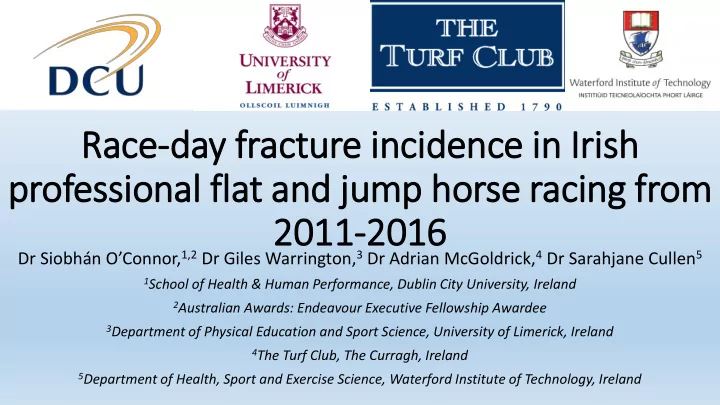

Race-day fracture in incidence in in Ir Iris ish professional fla lat and ju jump horse racing from 2011 2011-2016 2016 Dr Siobhán O’Connor, 1,2 Dr Giles Warrington, 3 Dr Adrian McGoldrick, 4 Dr Sarahjane Cullen 5 1 School of Health & Human Performance, Dublin City University, Ireland 2 Australian Awards: Endeavour Executive Fellowship Awardee 3 Department of Physical Education and Sport Science, University of Limerick, Ireland 4 The Turf Club, The Curragh, Ireland 5 Department of Health, Sport and Exercise Science, Waterford Institute of Technology, Ireland
Background • Professional horse racing • Competitive & popular but considered high risk • High incidence of falls and injuries reported on race-days • Fractures 2 nd most common injury reported on race days • Flat racing • Characterised by its high speed nature (up to ~70 km·hr -1 ) from a stall start and covering distances ranging from 1 to 4.4 km with no obstacles. • Jump racing • Starts from a tape barrier • Involves fences/hurdles • Distance 3.2-7.2km • Jockeys must: • Sit on a horse approx. 3m above the ground • Uses muscular strength, endurance & balance to coordinate a dual partnership with the horse
• Fracture rates reported recently in • Australia (Hitchens et al., 2012; Curry et al., Study Aim 2016) • New Zealand (Bolwell et al., 2014) • California (Hitchens et al., 2016) • However, last research in Europe was Rueda et al. 2010 • Ireland, Uk & France from 1999-2006 • Aim • Provide a comprehensive longitudinal analysis of fracture incidence from race-day Irish professional flat and jump jockey falls over the last six years
Methods • A minimum of 2 designated Turf Club medical doctors attended all race meetings • All race-day injuries including fractures recorded from 2011-2016 • Standardised injury report form • Senior Medical Officer collated all injury report forms after each race meeting. • Injury Analysis • Fracture rates & their 95% CI were calculated • /1,000 falls • /1,000 rides • /1,000 race meetings • Examined changes in injury rates between 2011-2016 • Compared jump v flat racing
• 2011-2016 • Flat racing – Fractures ↓ Results • Falls • IRR=0.81 (076-0.87) • Jump > Flat • Race Meetings • IRR=0.76 (0.66-0.87) • Rides • Rides • 1.96 v 0.20 /1,000 rides • IRR=9.80 [5.70-16.85] • IRR=0.77 (0.25-2.32) • Race Meetings • Jump racing – Fractures ↑ • 149.4 V 13.93 /1,000 Meetings • Falls • IRR=10.73 [6.24-18.44] • IRR=1.12 (1.04-1.21) • Flat > Jump • Race Meetings • Falls • IRR=1.04 (0.99-1.07) • 54.47 V 40.15 1,000 falls • Rides • IRR=0.74 [0.43-1.27] • IRR=1.090 (0.78-1.53)
Comparison To Previous Data • Fractures prevalent in horse racing • Flat • Fractures /1,000 falls is lower now than between 1992-2000 (McCrory et al., 2006) • (54.5 V 98.9) • Jump • Fractures 1,000 falls is higher now than between 1992-2000 (McCrory et al., 2006) • (40.2 V 34.3)
Discussion • Almost X10 more likely to occur in a ride in jump racing than flat • A fracture occurs in every 18 and 25 falls in flat and jump racing respectively. • A welcome trend is the reduced fracture incidence in flat racing over the last six years, with a notable 24% reduction in fractures during race meetings. • In contrast, fractures have slightly increased in jump racing, but this was only statistically significant in falls, with a 12% increase noted.
Conclusions • Fall training programme to teach appropriate fall mechanics required • Especially in jump jockeys • January 2017 • New safety vests introduced which have the potential to minimise fracture occurrence • Next step is to examine the effectiveness of this injury preventative strategy
Contact Me siobhan.oconnor@dcu.ie @SiobhanOConnor3 https://www.researchgate.net/profile/Siobhan_Connor
Recommend
More recommend